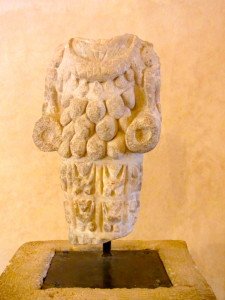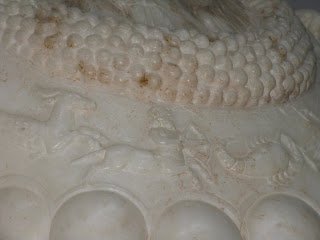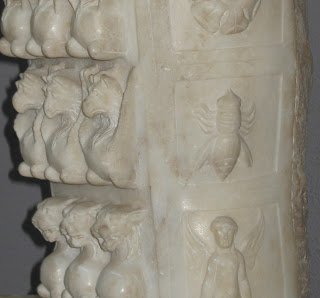
Blog & Resources
Looking for my thoughts on everything from bioethics to movies? You came to the right place. And while you’re here, check out my free downloadable resources.
Sign up to be notified when new posts release.
Artemis of the Ephesians: A Conversation with Wayne Stiles
Our understanding of Artemis of the Ephesians at the time of the apostle Paul has, I believe, implications for how we read 1 and 2 Timothy. Recently I spoke with Wayne Stiles with Walking the Bible Lands about my research on this goddess and her influence, especially in the Province of Asia. You can watch our conversation in this video.
Right now I'm working on two books right now relating to the Ephesian Artemis and the ramifications for women and our understanding of first-century backgrounds—one a work of fiction and the other, an academic book.
My readers can get a free video series on Jesus's life from Walking the Bible Lands courtesy of Wayne.
The Artemis of Acts 19: Not a Fertility Goddess
 For years I've been studying the identity of Artemis of the Ephesians as the earliest Christians would have understood her. I think a correct understanding of her cult has ramifications for how we read 1 Timothy. Part one of my conclusions recently appeared in the scholarly journal Bibliotheca Sacra. You can now read my first Artemis Bib Sac article online.Photo: Remains of a second-century statue of Artemis of the Ephesians that I saw when visiting Jordan, some thousand miles away.
For years I've been studying the identity of Artemis of the Ephesians as the earliest Christians would have understood her. I think a correct understanding of her cult has ramifications for how we read 1 Timothy. Part one of my conclusions recently appeared in the scholarly journal Bibliotheca Sacra. You can now read my first Artemis Bib Sac article online.Photo: Remains of a second-century statue of Artemis of the Ephesians that I saw when visiting Jordan, some thousand miles away.
Ephesians: Power and Magic
 In 16 B.C. Rome was so full of people selling powers that all the magicians were expelled from the city. Years later Vespasian outlawed astrology, too. Yet because of his friendship with a famous Ephesian astrologer, Balbillus, Vespasian allowed Ephesus to continue holding "sacred" games in Balbillus’s honor.
In 16 B.C. Rome was so full of people selling powers that all the magicians were expelled from the city. Years later Vespasian outlawed astrology, too. Yet because of his friendship with a famous Ephesian astrologer, Balbillus, Vespasian allowed Ephesus to continue holding "sacred" games in Balbillus’s honor.
In the Book of Acts we find a story set in first-century Ephesus about magicians who convert to Christianity (Acts 19:19). They bring out their expensive magic books and build a bonfire with them. (Note the difference between choosing to burn your own books and having someone confiscate them against your will…)
This happened in a context where Artemis of the Ephesians was believed to be powerful enough to overcome the astrological world. When I photographed her first-century statue last summer, I noticed the signs of the zodiac inscribed on her chest (above). And a statue of Hecate, the goddess of the underworld, stood in her temple. One theory as to why Artemis’s “legs” are  covered with animals is that she was considered to have power over anything in the earthly realm, including human and beast.
covered with animals is that she was considered to have power over anything in the earthly realm, including human and beast.
So thanks to Artemis, Ephesus was a center of commerce for people trafficking in the supernatural. Magicians could charge a lot for love potions. Or people would give them large sums to create curses using a combination of the “Ephesian letters”—a set of separate letters that people had inscribed in leather that they would use in varying combinations for spells.
Scholar Clinton E. Arnold sees a connection between Ephesus’s reputation for the demonic and the biblical Book of Ephesians, which includes the only extended section in the New Testament about how to arm oneself against the dark powers (e.g., shield of faith, sword of the Sprit). That’s not to say he thinks the Book of Ephesians was written only to those in Ephesus. He sees all of western Asia Minor engaged in an ongoing struggle against “powers.” Nor does he see the Book of Ephesians as purposed primarily for “casting out demons” or anything like that. What he does see is a cultural background that could explain why “power” as a motif keeps showing up.
In Paul’s epistle, we find Christ presented as supreme and exalted, which would have comforted believers coming out of the occult and fearing what the powers of evil might do to them. Paul assures his readers about their new identity—that of new citizens transplanted from the dark kingdom to the kingdom of light. He describes them as sharers in divine power through faith, and he describes the evil order as led by the enslaving "prince of the authority of the air." Though Paul acknowledges the continuing power of evil, he assures believers that ultimately all powers will be subjected to Christ.
All of this Arnold lays out in his scholarly work, Power and Magic: The Concept of Power in Ephesians. His findings fit with my theory that the words "a woman shall be saved through childbearing," written to Timothy in Ephesus were not a pronouncement about a woman's "place." Rather, they were intended as an encouragement to new Christ-followers who had departed from Artemis, also the goddess of midwifery. The new converts did not need to fear Artemis's rage and thus fear dying in childbirth. Why? Because Jesus is stronger than Artemis.
Yes, Arnolds's book was another on my "antiquities" list. The good news is that my three bibliographies have finally been approved for my exam fields. (I've been waiting since August.) That means I hope to take my PhD exams within the month. Feel free to speak on my behalf to the One with ultimate power!
Why Ephesus?
The book I just finished is divided into two major sections. The first lists everything said about Ephesus in antiquity by more than thirty authors—from Pausanias to Seneca to the writer of Luke’s Gospel. Murphy-O'Connor also adds his commentary full of helpful explanatory notes.
Why am I so interested in Ephesus, a city in present-day Turkey that laid in ruins for more than a thousand years? Because it is a key historical site. Cleopatra’s sister was murdered and buried there. Cleopatra and Mark Antony gathered their ships at one of Ephesus’s two harbors before their ill-fated battle at Actium. And it was the capital of Asia at one time.
If you wonder why I didn't mention the New Testament Book of Ephesians, I actually don't think that book was written only to the church at Ephesus. The words "to the Ephesians" don't appear in the most reputable early manuscripts, and one early list of Paul's letters omits the letter to the Ephesians, but does mention a letter to the Laodiceans. (Ancient Laodicea was not far from Ephesus.) I think it was written to both. Considering that Paul lived in Ephesus and had many, many friends there, it's odd that the Book of Ephesians contains no greetings to anyone if he intended it for only that church. Yet the omission makes sense if he intended his letter to be read in more than one location.
The city captured our imaginations when my husband and I visited there during our twenty-fifth anniversary cruise, and I still haven't gotten over it.
Who Was Artemis and Why Does It Matter? Part II
In modern cities when a woman goes into labor, relatives squeal, cheer, and celebrate. But in first-century Ephesus, the response would have been much different. Think terror. Childbirth in the ancient world carried legitimate fears of writhing and death—as is still true in much of the developing world today.
In Part One, I said first-century Ephesians worshiped a uniquely Ephesian Artemis whose re-built temple was the crown jewel of the world’s Seven Wonders. This Artemis was the illegitimate daughter of Leto and Zeus, sister of Apollo, goddess of the hunt, and a confirmed virgin. Yet Artemis Ephesia had additional characteristics. And one of these was her association with childbearing.
Many who hear this instantly think “fertility, mothering, and nurturing.” Yet such associations are probably unfounded. In the same way midwives and obstetricians deal only with delivery and not sex, fertility, mothering, or nurturing, Artemis was a deliverer only. In fact Artemis and Apollo shot arrows through all the children of Niobe—Apollo killing the sons, and Artemis, the daughters. Hardly nurturing!
So how did such a ruthless goddess come to be associated with childbirth?
In Homer’s Hymn to Delian Apollo (ll. 89–101) he describes the birth of Artemis’s twin saying, “Leto their mother was racked nine days and nine nights with pangs beyond wont…” Imagine! Artemis—as the myth goes—along with three other goddesses, watched her mother writhe for a week and a half. From her first day she was linked sympathetically with the birth event.
Strabo (63/64 BC – ca. AD 24) in Geography locates the place of Artemis’s birth as a grove just outside Ephesus. Perhaps this connection with her birthplace and the annual celebration of her birthday caused citizens to link Artemis of the Ephesians with birth.
Regardless of how the connection came about, we know it was well-established by the third century B.C., because in his biography of Alexander the Great, Plutarch (A.D. 46–120) refers to Artemis Ephesia’s role in childbirth saying, “Alexander was born…the same day that the [first] temple of Artemis at Ephesus was burned.” The temple, he says, “took fire and was burnt while its mistress was absent, assisting at the birth of Alexander” (italics added).
So we see the link to delivery–but sans fertility. Artemis was, in fact, immune to love, sex, and marriage. In Hymn to Aphrodite, Homer says Artemis cannot be tamed by Aphrodite. That is, Artemis remains a perpetual virgin. (Read the myth of Actaeon to find out what happens to a male who sees Artemis nude. It’s R-rated—and not for sex. ) Words such as tomboy, bodily chaste, volatile—these fit Artemis far better than mother, nurturer, and goddess-of-fertility.
Strabo (Geography 14.6) wrote, “Artemis has her name from the fact that she makes people ‘Artemeas’ meaning sound, well, or delivered.” He lists several members of the Greek pantheon including Artemis and adds, “Pestilential diseases and sudden deaths are imputed to these gods.”
It may seem strange for one persona to be linked with both delivery and death. Yet this makes more sense when we consider the sorts of prayers women offered: “Deliver me safely or kill me quickly!”
Another word that shows up when Artemis is mentioned is “save.” The ideas of “deliver” and “save” do go hand in hand. And in Pausanias’s writings we see with relative frequency references to Artemis Ephesia as “savior.” In addition to his writings, we find references to “Artemis Savior”—twenty of them!—in ancient inscription evidence.
So Artemis Ephesia is one who saves or delivers. And she is deemed to have the power to deliver a first-century woman through the most dangerous of passages—childbirth. Though not a man-hater or a radical feminist as we understand the word, Artemis was a virgin, and her priestesses and cult leaders appear to have been virgin girls, sexually inactive wives, and widows.
So what does all this tell us?
Here’s one ramification among many: The first epistle to Timothy (1 Timothy) is intended for a recipient who resides in Ephesus (1:3). So knowing what we do about the influence of the Artemis cult there, one wonders—might there be a connection between the abstinence lifestyle associated with Artemis worship and repeated mention in 1 Timothy of young widows, old widows, widows causing difficulty, widows needing to marry and have children, and people forbidding to marry (1 Tim 4:3)? And might this explain why Paul, when writing to recipients in over-sexed Corinth, suggested that widows consider celibacy (1 Cor. 7:8), yet when writing to under-sexed Ephesus, he wants younger widows to marry and have children (1 Tim 5:14)?
Artemis, part i
It was my day to post over on the Tapestry blog. I just finished a six-credit-hour independent study looking at Artemis of the Ephesians. Today's post was part one of two of my conclusions.

